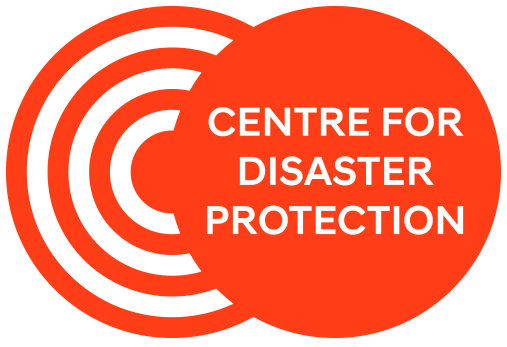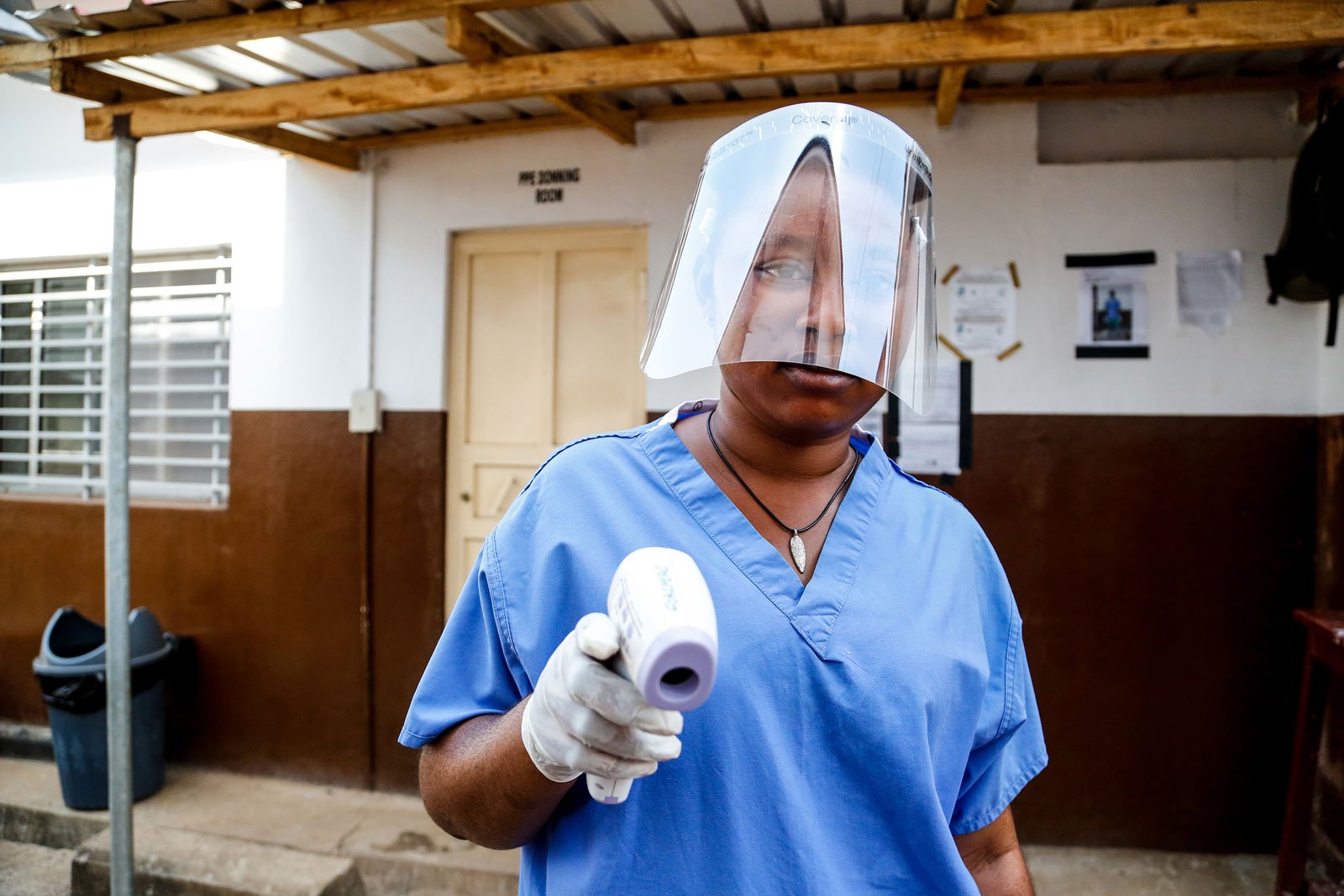Funding covid-19 response: Tracking global humanitarian and development flows to meet crisis needs
by Ruth Hill, Dillan Patel, Yi Yang, and Jon Gascoigne [1]
Photo: Simon Davis / Foreign, Commonwealth & Development Office (FCDO).
Over the next few months, the Centre for Disaster Protection will be tracking humanitarian and development funding directed at helping low and middle-income countries manage the health and economic costs of covid-19. This is our first update on how much has been committed and disbursed and to whom. Future blogs will examine in many of these issues in more depth, such as the degree to which this is new money, and whether finances are being received in a timely manner. We will also highlight specific countries where needs appear to be great, but funding for response is low.
There have been many announcements of funds to help countries manage the health and economic consequences of covid-19, but how much is actually on its way (committed) and how much has arrived (been disbursed)? Our first assessment of financial flows from multinational institutions shows that, as at 10 June, a total of US$48 billion has been committed. The funds committed are substantial, reflect new money in some cases, and are being disbursed. All within three months of the first one hundred reported cases in a low or lower-middle income country. Much good news.
However, because the international system relies on the equivalent of low-interest credit cards to help countries manage crises, our assessment shows that poorer countries have access to less cash to manage the crisis. More cash has been made available in the places that have the largest economic losses, but not the places where poverty will increase most because of covid-19. If this pattern continues throughout the crisis, the global response might manage the economic fallout very well—but it will not put people back on a secure path out of poverty.
As funds continue to be committed, we need to watch closely and ensure that funds are directed to countries and programmes that allow the poverty impact of the crisis to be reduced. This may require providing more funds on grant terms. Our findings also highlight the need for reform in how the world pays for crises in the first place. Low-interest credit cards are important, but not enough. We also need good insurance.
The scope of our work: what money are we tracking?
We are looking at funds committed and disbursed by the International Monetary Fund (IMF), the World Bank, regional development banks, and as part of the United Nations COVID-19 Global Humanitarian Response Plan (GHRP). In the case of the first three, we have accessed data directly from institutional financial reporting. We are only able to aggregate what has been reported and are aware that we are missing loans from two of the regional banks (the African Development Bank and the Inter-American Development Bank) as well as some additional finance added to existing World Bank loans (both World Bank and International Finance Corporation (IFC)). Data on GHRP flows is provided by the UN’s Financial Tracking Service—we are collaborating with Development Initiatives to better understand this particular piece of the puzzle.[2]
The good news: funding has been significant and timely
As at 10 June, a total of US$48 billion has been committed by international institutions to help countries manage covid-19. Most funds have been committed by the IMF (US$23 billion) and the World Bank Group (US$13 billion). US$6.8 billion has been committed by Asian Development Bank (ADB), US$2.3 billion has been committed by Inter-American Development Bank (IDB), US$1.5 billion has been committed by the African Development Bank (AfDB), and US$1.3 billion has been committed through the UN GHRP. Nearly all of this—96%—has been in loans, about 27% of which on concessional terms from the IMF and World Bank. This is a considerable amount of funding given the first one hundred cases in a low or lower-middle income country were reported less than three months ago.[3]
Commitments to Covid-19 response by international organisations ($ mil)
The biggest single commitment outside of this multilateral system is the suspension of debt payments on bilateral debt that was agreed to by G20 countries for 77 of the world’s poorest countries. Lack of transparency makes it hard to quantify the value of bilateral debt but it looks like this would amount to about US$9.6 billion were all G20 countries to follow through on the commitment.
The speed on the commitment side is largely mirrored on the disbursement side. Debt payment suspension (in the form of loan re-payment holidays) provides immediate additional fiscal space to governments allowing them to spend on other emergent needs such as health system strengthening and transfers to households. New IMF loans are disbursed in a one-time payment within six months of signing. Over half of the World Bank loans had started disbursing in April across all regions including sub-Saharan Africa and South Asia. There is less consistency in terms of the status of the funding reported in the UN GHRP—i.e. whether it is money on its way or arrived—but in some cases it reflects money that has arrived, which suggests disbursement is underway.
There are indications that much—but not all—of this is new money. Whilst emergency loans from the IMF are more clearly new money, the World Bank is lending from its existing capital, so a key question is whether the new loans represent additional lending or repurposed loans? Covid-19 funds being lent to the world’s 76 poorest countries (countries that borrow on concessional terms from the International Development Association (IDA) part of the World Bank) is being financed through currently unused IDA resources. Countries that borrow on less concessional terms from the International Bank of Reconstruction and Development (IBRD) part of the World Bank were able to access additional un-used IBRD capacity for lending. A good way to assess the level of additional money is to look at overall flows compared to ‘normal’ as is done here.
Room for improvement: so far, funding has prioritised economic losses and not poverty increases
So far, the funding has disproportionately gone to better off countries. The funds received per capita are higher for those living in richer middle-income economies and lower for those living in countries with higher poverty rates. This may partly reflect the fact that this crisis, so far, is hurting richer countries more. Richer countries have had larger caseloads and larger predicted growth impacts.
Are funds going to countries that have experienced the largest covid-related losses? The funds received per capita are higher for countries that are ranked as having a higher pandemic risk (Inter-Agency Standing Committee/European Commission INFORM COVID-19 Risk Index), and countries with a bigger expected shock to gross domestic product (GDP) growth (economic growth estimates from the IMF). But countries with the highest expected poverty impacts have received less per capita, showing that funds have been directed towards economic losses rather than the places where poverty will increase most because of the crisis (US$1.90 poverty rate estimates from the World Bank).
Benchmarking loan commitments against estimated impact on poverty
Benchmarking loan commitments against estimated impact on GDP
Benchmarking loan commitments against covid-19 risk
Financing disaster response with loans has challenges
This unequal allocation of funds likely reflects the fact that the largest financial flows are loans. Richer countries are better able to pay loans back, so they can access more money. It just isn’t possible to lend the same amount of per capita financing to a poor country at high risk of debt distress as a middle-income country that will be in a better position to pay it back. This is true even though the loans given to the poorest countries are highly concessional (provided at zero or very low interest rates with a 5–10-year grace period). Given loans are the largest overall source of financing in a disaster, disaster finance goes to those that can take loans.
In fact, the World Bank explicitly allocated its lending proportional to GDP. The allocation proposal that was approved by the World Bank board in March stated that ‘Each country would have access to 0.1 percent of GDP subject to floors and caps.’ This allocation rule also reflects the financial position the World Bank was in when the crisis struck. The pandemic hit four months before the IDA replenishment (1 July) leaving IDA countries with access to only what was left in the pot. IBRD had more additional money to lend. Last year half of the money the Bank lent was to IDA countries. In contrast only 32% of anticipated covid-19 lending was expected to go to IDA countries. The lending from the IMF has followed a similar pattern.
The grants that have been committed to countries through the UN GHRP are more likely to be directed to poorer countries. These funds do make the overall picture more equitable—but these grants are small compared to the overall flows, so they do not make a big difference to the amount of money available to countries now (even though their overall grant value is much higher than a loan).
What needs to change?
More grants and concessional funds are needed to address the lack of funds going to countries experiencing larger poverty impacts. We will monitor whether this situation improves when IDA-19 becomes available from 1 July.
We need to take note of the design flaws in the current system (even while we celebrate that much is working well). Responding to crises with large amounts of lending and small amounts of grant funding inevitably leaves some countries out. Countries, just like people, need insurance when disaster strikes, as well as low interest credit cards. The world needs good development insurance, not just development banks, if countries are to be well-protected against large humanitarian and economic shocks.
Footnotes
[1] The author list in this blog has been randomised using the author randomisation tool on the American Economic Association website.
[2] Other large sums of money have been committed outside of international institutions. We include an assessment of the value of the G20 commitment to the suspension of bilateral debt payments (the actual value of agreed suspensions is not reported). There are some aspects of financing we do not include. Financing committed to vaccine development (such as the Coalition for Epidemic Preparedness Innovations (CEPI) US$446 million commitment) is largely spent in high income countries and is not included. Bilateral support provided directly to countries by donor governments or from other institutions such as the Bill & Melinda Gates Foundation and Gavi, the Vaccine Alliance Partnership is not yet included.
[3] 15 March 2020 in the Philippines, based on data reported by the Centers for Disease Control and Prevention (CDC).
The Centre’s Glossary of Terms can be found here.





